
Small Business Website Design: How to Get a Competitive Advantage Without Breaking the Bank
I'm not going to lie to you. Websites are expensive.
But when you're an aspiring small business, it's one of the most important investments you can make.
Because a website can be more than a site.
It can be your receptionist.
It can be a library for your customers.
It can be a customer vending machine.
If you let it, your website can be the entire backbone of your business. It doesn't have to sit there and only look pretty. Despite what you've read on Quora or what your son-in-law that works at an ad agency and knows everything about websites told you, you don't have to break the bank to get this type of site.
All you need is for someone to give you the right approach, tools, and features. And that person is me.
Small Business Website Design: How To Get It Done
The first website I ever built was for a small business. It was a local diner in Wilmington, N.C called The Dixie Grill. In perhaps the best example of bootstrapping, the owner couldn't pay me monetarily, so he paid me in breakfast.
(I was quite literally bringing home the bacon.)
Since I was a newb, I set the guy up with a WordPress site and used a free template for the design. I made a few pages, uploaded a breakfast, lunch, and dinner menu and linked to FourSquare and Yelp. The final result wasn't great, but it was a functioning website with the hours of their business and the menu items.
Shockingly, this website is still out in the wild and is the first result when you google the diner.
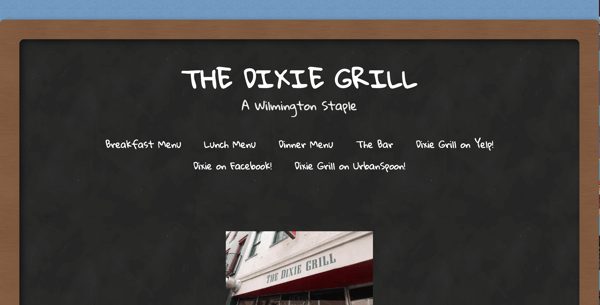 In retrospect, there's a lot I would change. The fake blackboard background has got to go.
In retrospect, there's a lot I would change. The fake blackboard background has got to go.
(If you're reading this, diner owner, I will redo this website for the same price as before - a ton of hot, crispy bacon.)
It's been years since I built that website, but I still believe wholeheartedly that every small business needs one.But a lot of small companies sleep on it and don't invest in a site because:
1) They assume it will be ridiculously expensive.
2) They don't have any idea where to start.
3) They do not understand how it will benefit them whatsoever.
Overall, they assume that sites need to be complicated to be successful. They think the more content you have, the better. And for some industries, that's true.If you're a huge company and you hire an agency for $50k-$80k, you will get a fantastic site. They can take months to make, but these websites are often worth the cost.
The alternative solution is getting a website on Wix or WordPress. These sites are cheap and get the job done. However, despite the amount of work you put in, these sites tend to suck. They are the color-by-number version of a website.
That's where my third option comes in, using a modular building system. With this website design approach, you get the best of both worlds. You get a custom, yet a cost-effective website. The content will be good, the visuals will be great, and you can use the site to crush your conversion goals.
Here is how you can get this kind of site up and running.
#1: Make Sure Your Personas Are Recent
Buyer personas are one of the most useful, yet underutilized marketing resources out there. People build them out once, then stick them in Google Drive. Larger companies that appeal to broader demographics and utilize the paid search train to acquire hundreds of leads can get away with this.
As a small business, incredible buyer personas are too much of an opportunity to pass up. You have an advantage. While larger companies have a ton of leads and customers, they don't necessarily ever get to know them that well. They can buy market research or hire expensive consultants and call it a day. But you know your customer. You talk to them all the time.
That's why if you use that intimate relationship to help guide your strategy, you can create a high-converting website. All you need to do is document the real thoughts, ideas, preferences, and frustrations of your customer. You apply all of that information to your buyer personas.
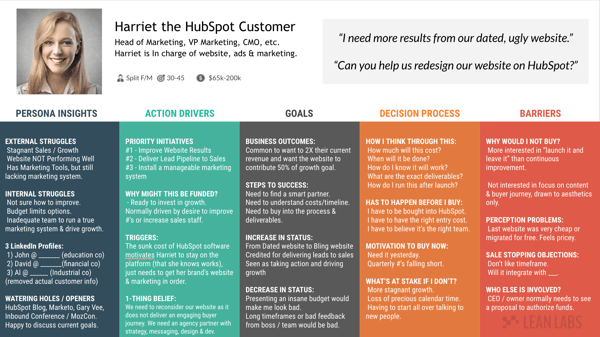 I use this buyer persona document. Since it's a one-page strategy sheet, the only information that lives on it is critical insights. No fluff. You'll take this template and begin filling it out. And I don't mean sit down for an hour or two and finish it yourself.
I use this buyer persona document. Since it's a one-page strategy sheet, the only information that lives on it is critical insights. No fluff. You'll take this template and begin filling it out. And I don't mean sit down for an hour or two and finish it yourself.
You need actual research. You can acquire it that information with:
A customer interview.
I love talking to clients. It's one of my favorite tactics for getting better information about what they want and expect from a website. I would recommend reaching out to customers and asking them if they'd be willing to conduct a twenty-minute phone conversation. If they agree, set up a time and email them the 10-15 questions you plan on asking at least two days in advance.
The questions that will inform your buyer personas include:
- What are your 3-5 top challenges right now?
- Where do you go to connect and have conversations with your peers? Which channels are more active than others?
- What are the top three things you want to accomplish this year, as it pertains to business and personal goals?
- What would prevent you from acquiring the funding or budget to accomplish those goals?
- Why did you need to solve your problem when you became a customer? What aspects triggered it?
- Why do you believe (or know) that this solution will help you achieve your goals?
- What do you hope will happen after you meet your goals?
- What will happen if you do not meet your goals?
- What are some factors that contribute to your choice to buy?
- What has to happen before you buy?
- What are 3-5 reasons that would prevent you from buying?
- What are 3-5 deal breakers as it pertains to this solution?
Those seem like a lot of questions to ask, but each one matters. If you don't have anyone to call, trying reaching out within your industry to find prospective customers that would be willing to conduct the interview.
Scour forums.
Whenever I have a problem or issue with a product or service, I go straight to Twitter. In my experience, it's one of the only places that a brand will respond to you. I @ them and describe my feelings about how the product didn't work, or the service wasn't up to par. And if you're a small business, you can use these insights to inform your buyer personas.
You can quickly locate conversations on Twitter and document common trends in challenges or frustrations.
The best ways to find these topics include:
- Use a hashtag search tool such as Hash At It.
- Finding examples of your persona (real people that match the attributes) and read through their feeds.
- Find weekly Q&As on Tweet Reports.
However, this can be a tedious process. If you want to go this route, you can consider hiring an UpWorker for a few hours. You can also take this approach to find and analyze conversations in Facebook Groups, on Reddit and Quora, as well as LinkedIn.
Feel their pain.
There are a lot of review sites out there, depending on your industry. For instance, if you sell a platform or software, you could have reviews on Capterra, TrustRadius, and Trustpilot. And even if you don't, larger companies likely will. You can sort through their worst reviews to see what missed the mark for customers. It's another opportunity to employ a freelancer if you don't have the time.
Overall, the goal is to complete your buyer personas with accurate information and avoid assumptions. If you assume too much and base your strategy off ideas of what will work, you can invest a lot of time in website content, marketing initiatives, and sales tactics that don't pay off.
Invest in a survey.
Surveys can be great for getting preliminary information about customer preferences. And for small businesses, these surveys can be a game-changer. Here's the idea. You send out a questionnaire that asks about how the customer approaches the buying process, what would turn them away and how they use technology (or don't use technology) to convert.
You can use a service like Typeform and SurveyMonkey to go about this. Surveys can take a few weeks to collect valuable information, so stick with it. You can use your email list or individually reach out to customers that may have an interest. You could also reach out to industry influencers to request their feedback.
I would use this exercise to ask questions such as:
- What kind of information are you willing to share on a form?
- What would need to happen on a website to turn you away?
- How often do you read website blogs? Which ones are your favorite?
- Do you prefer phone calls or email?
- Would you be open to communicating with a brand on social media, such as Facebook Messenger?
- Would you prefer to get a response right away from a chatbot, or are you willing to wait for a person?
You get it. You can gauge the experience the customer prefers and run website performance monitoring later to see if you're on the right track.
I would prioritize getting these buyer personas right before doing anything else for a website build.
#2: Follow Their Journey
The customer journey map is one of my favorite website resources, but it requires an open mind. You need to humble yourself a little. It requires seeing everything from the customer's perspective instead of your own. And it starts with documenting the customer experience as is.
You will record what it's like to find you, work with you, and become a customer with you right now. Not when you start to sell a particular product or what you wish the experience were. You want to focus on what it would be like if someone started on their buyer journey and became a customer of yours today.
You can start by selecting one of your personas and downloading the buyer journey template.
I use this one.
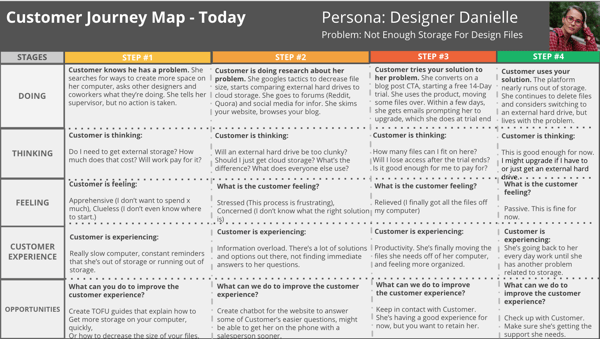 From there, you go through each step and stage. During phase one, your customer knows that he or she has a problem. For that step, you record what they're doing, what they're thinking and feeling and their overall day-to-day experience as it relates to the problem.
From there, you go through each step and stage. During phase one, your customer knows that he or she has a problem. For that step, you record what they're doing, what they're thinking and feeling and their overall day-to-day experience as it relates to the problem.Here are all of the steps and how each one breaks down.
The customer knows there’s a problem.
A few months ago, my home would get unreasonably hot during the day. It was smack dab in the middle of a typical North Carolina summer. I started to turn the air conditioner down lower, and it would take forever to reach the optimal temperature. When I ran my hand across my vents, I could faintly feel cold air.
When my house failed to drop below 72-74 degrees even when the A/C was blasting, I knew there was a problem. I was playing with the A/C and examining the outdoor unit. I felt worried that I would need to replace the entire system. On a day-to-day basis, I did not sleep well, the house felt stuffy, and I worried about the health of my dog.
The customer is researching the problem.
I searched for various things during this time, including "house gets super hot when A/C on," "signs your AC is breaking," as well as the make and model of my air conditioner and thermostat. I eventually called local air conditioner repairers and filled out forms citing my concerns. I asked them about quotes. I set up appointments.
I did all of this from my computer. Most of the time, I could fill out a form with a note and the professional would follow-up on the phone the next morning. One forward-thinking company even made it possible to book an appointment online. While I waited for responses, I tried to find information that could tell me how much this was going to cost, and whether or not I could get a loan to cover it.
The customer tries your solution.
After nearly three weeks without an air conditioner, I bought an air conditioner from a local shop. I took out a loan through their recommended financier. The process had a few little road bumps. The company got the new unit in quickly, but I had limited options financially.
When I got on the phone with the loan agent, I got the runaround. That part of the process was uncomfortable. The actual installation was pretty painless, and I had cold air in hours. The company even installed a new Nest thermostat, which I could download an app for and run remotely from my home.
The customer uses your solution.
I've had the air conditioner for a few weeks. So far, so good. It runs well. The house is cold. I haven't heard from the company since the installation. The app is fun to use but doesn't have a ton of benefit. At this stage, you have an idea of the customer experience for that step and can analyze it accordingly.
For each stage, you want to ask yourself how, in that specific situation, you could better serve the customer. At every step, how could your company have been more supportive or innovative in providing a solution?
When you complete this exercise, you move on to the ideal customer journey map. Here is where you will take your findings and describe the perfect customer experience. Look beyond your current capabilities and dream big.
The goal is to record a process that would give the customer everything they would need to proceed.
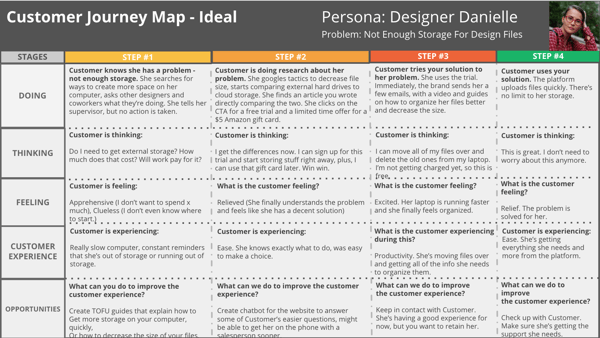 After you finish, you can compare and contrast to see where your experience is falling flat.
After you finish, you can compare and contrast to see where your experience is falling flat.#3: Start Lean
After you're done collecting critical customer research, you will want to start working on your website. However, if you jump right into brainstorming site and landing pages, you will end up with way too much content.
Instead, you want to step back and look at something called the buyer journey.
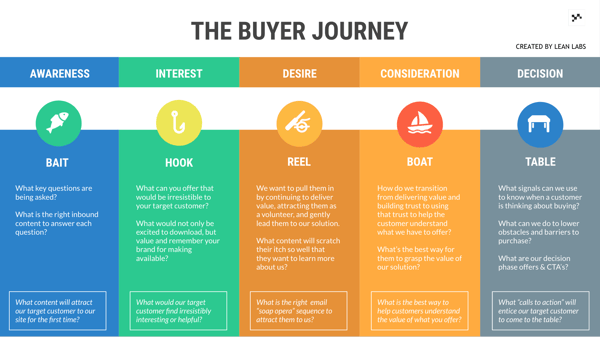 The buyer journey is famous in marketing. It consists of every stage of the buying process. During this process, the customer becomes aware of a problem they have, begins to search for an answer, chooses a solution, etc. And if you can document what your customer needs at every stage, you can build the necessary material to support their needs.
The buyer journey is famous in marketing. It consists of every stage of the buying process. During this process, the customer becomes aware of a problem they have, begins to search for an answer, chooses a solution, etc. And if you can document what your customer needs at every stage, you can build the necessary material to support their needs.Additionally, a buyer journey helps you understand what content is necessary and what content isn't. It helps streamline your website and create impactful, yet minimal conversion points from start to finish.
Here is each step of the journey and typically, the pages and types of content that support them the best.
Awareness
.png?width=200&name=1%20(1).png)
During the awareness stage, you want to create material that baits your ideal customer. This type of content typically consists of content like blog posts, podcast recordings, and more. A lot this content should come from the questions that your customer is asking.
For instance, in my example of the broken air conditioner, I wasn't aware of the specific problem (broken air conditioner), but I knew it was hot. I began searching for the answers to questions such as:
- "House gets hot when A/C is running."
- "Early signs that your A/C is breaking."
- "How to tell if your thermostat is working."
- "A/C vents are not blowing enough cool air."
- "Dangerous internal temperatures for a house."
If a local air conditioning repair business wanted to get my attention, they could create blog content around these keywords and phrases. They could make an offer that could broadly cover all of my concerns about a broken air conditioner, such as: "How To Survive The Summer With A Hot House."
The offer isn't directly selling a new air conditioner or repair and focuses on helping the lead solve their immediate problem, an uncomfortable house in the middle of the summer. It relates to your website build because:
1) It informs a page you will need to create.
2) You start thinking about delivery methods. Will your customer fill out a form? What fields will be on that form?
3) How can that asset initially catch your ideal customer's attention and how can it help guide them through your site?
Interest
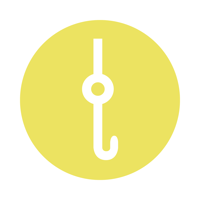
At the interest stage, you want to hook the customer. The content you share here should be valuable to your persona. For the air conditioner example, a compelling resource could be a quick worksheet or quiz to help customers figure out if their AC is on the fritz.
It's valuable because it provides an answer to challenge and also helps the provider qualify me as a lead. With these types of resources, you can collect specific details about the experience or challenge your ideal customer is having. And that customer benefits because they have information to inform their next steps.
Again, this is another asset that can inform your site flow and architecture. If a lead comes in on the worksheet, where next? What pages are necessary to support that experience?
Desire
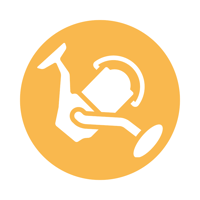
The desire stage is your reel. You want to pull the customer in with free guidance or expertise. As it relates to your website, pages that support the desired stage can be a list of relevant statistics (HubSpot is excellent at this.)
The air conditioner repair service could have a website page with statistics that help inform the customer further, such as:
- X% of air conditioners don't last over ten years.
- X% of air conditioners kept outside in cold climates need maintenance once-a-year.
- X out of 10 air conditioners that aren't producing cold air is leaking.
- X out of 10 compromised air conditioners stopped working two weeks after using coolant.
- X% of Top Air Conditioner Brand last for fifteen years or more.
You could also create a page of case studies that reinforce your value. At first, you don't need more than one or two case studies, and they can be short. The goal is to provide accurate, unbiased information that demonstrates how you're helping other people solve the same problem.
The best small businesses capitalize on any opportunity to build trust and rapport at this stage.
Consideration

The consideration stage is your boat. You bring the customer onboard with content that demonstrates the value of what you specifically offer. If you want to stand out during this stage, you can utilize video marketing. According to Neil Patel, product videos can increase purchases by 144%.
You can go even further with this and create customer testimonial videos. The air conditioner repair company could film a few simple videos that walk through the challenges a customer was experiencing, how long it took the AC company to install a new unit or make a recommendation, how easy it was to get financing, and more. Video marketing is critical later on in the buyer journey because they help the customer visualize the solution.
Additionally, a video is preferable at this stage because your customer may need to educate a stakeholder about your benefits. And you want to provide a resource to describe those benefits clearly. Otherwise, you will need to rely on your customer or existing marketing collateral to sell you.
Decision
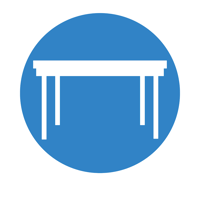
At the decision stage, the customer is yours to lose. It's critically important for a small business to get the process right here. You want website and landing pages that guide that lead forward. If it's too complicated or unclear, you will lose that potential customer and all of the time spent nurturing them will go to waste.
You will convert customers with enticing calls-to-action and their preferred tactics to convert. For instance, if your ideal customer strongly prefers giving information on the phone, don't ignore that. Ask for their phone number on a form and finish the process on a call.
When you're done moving through the buyer journey, you will have a ton of ideas for your website. To avoid going overboard, you want to extract deliverables from each stage. If I took all of the A/C company examples from above and made action items, my list of website pages would include:
- Blog for TOFU posts
- Landing page for "How To Survive The Summer With A Hot House" with a form and thank you page
- Landing page for "X Ways To Tell Your A/C Is Broken" quiz or worksheet with a form and thank you page
- Website page with statistics
- Website page for case studies
- Website page for customer testimonial videos
- Conversion page for A/C consultant with a form and thank you page
Of course, these aren't the only website pages you need. At this stage, you also need a homepage strategy, belief pages, a pricing page, an about us page, and any necessary legalese pages.
These are the essential business website pages to start with and will ensure that all of the information your customer needs is available on your site.
#4: Prevent Long Revision Periods
Even with a small team, getting all of your website pages made can be a challenge. Everyone is going to have a different vision. That's why there are a few critical strategy documents I use to ensure that everyone is on the same page.
First, there's the tone you want to take on your site.
Is your business fun and friendly?
Is it professional and serious?
This decision can inform your entire website content strategy and impact the voice you use in your messaging, emails, blog posts, and more. A brand voice exercise is perfect to answer these questions and help you settle on the right tone for your website.
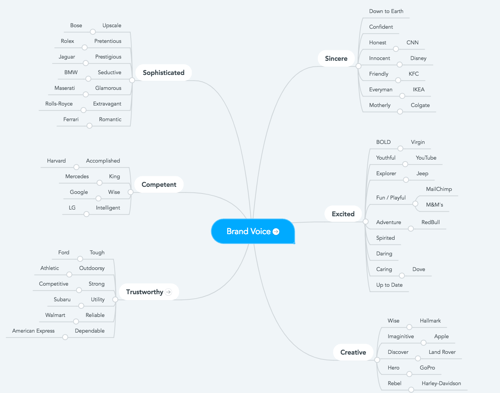
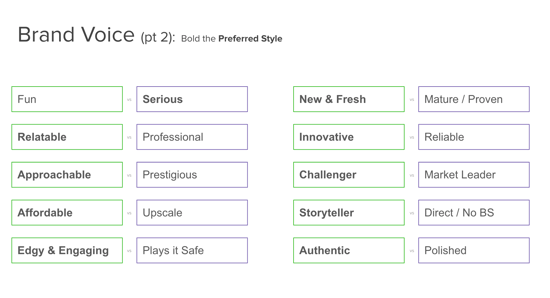
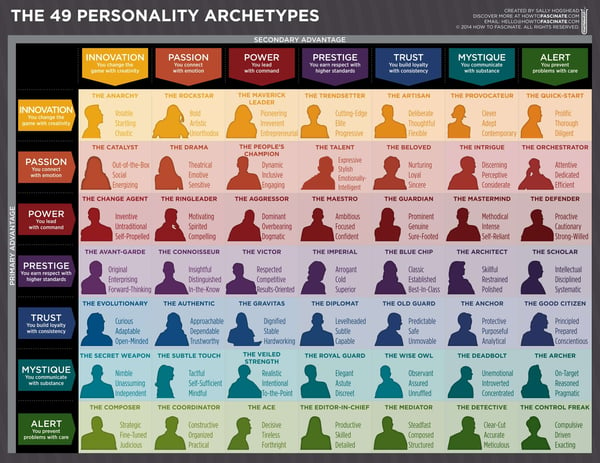
Second, there's the flow and architecture for all of the pages you need to make. I use page flows to outline all of my website pages. It comes before writing or styling anything on a site. With a page flow, you can document the objective for each page and get stakeholders to agree on the direction before moving forward.
You will a lot of time and resources with this step. There are various sections to a page flow, but each one is important for following a consistent narrative. I go from top to bottom, documenting what the page is, how it helps the customer, as well as what's at stake for the customer if they don't convert.
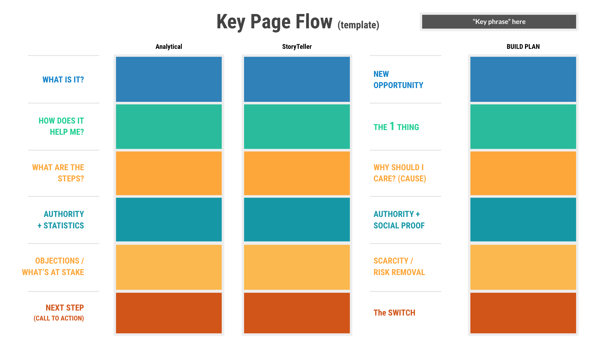 When those outlines are done and reviewed by the right people, you can begin to prototype your pages. Prototypes are one of the best ways to get the right format and flows for your website pages. I use Sprocket Rocket to build mine.
When those outlines are done and reviewed by the right people, you can begin to prototype your pages. Prototypes are one of the best ways to get the right format and flows for your website pages. I use Sprocket Rocket to build mine.It has a ton of modules to choose from, and I can easily drag and drop them on the page.
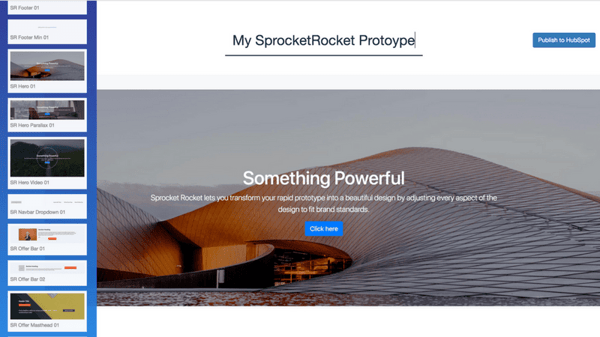
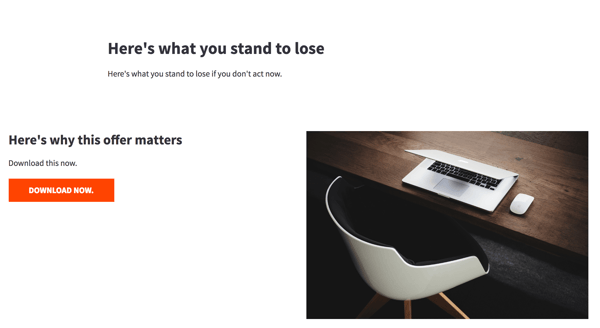
From there, I can hit "Publish To HubSpot" and draft the page. After that, I can drop in the messaging from the page flow, optimize and polish the copy and pass the pages to a developer to start designing. It's a ridiculously easy process.
An additional tip I have is to build a sitemap before you start piecing any of these website pages together. A sitemap is often known as "that thing you submit to Google," but it's also a grid that shows how all of your pages connect.
I use Slickplan for my sitemaps, but there are a ton of other free tools out there. You also need to consider your website's XML sitemap, a key component for how Google crawls your website. Again, there are a plethora of great XML sitemap generator tools out there.

You can also sketch a sitemap on a whiteboard, a sheet of paper, or in a Google Spreadsheet. It's up to you. As long as there's a plan for connecting your pages, you will be in good shape. You will know which pages need calls-to-actions added to them, and follow the path every customer will take from the homepage forward.
#5: Invest In All-In-One
During your website design process, an inevitable decision is which COS or CMS you will use. And if you're not careful, this is where your entire website can go off the tracks. One of the most critical mistakes that small businesses make is choosing the wrong system to build their entire site.
Many companies choose WordPress, and I understand why. That was my initial choice for website building. It's cheaper and quicker to get up and going. I could create a WordPress website right now if I wanted to. However, once you start looking through those pages and seeing how much of your site needs to connect, Wordpress quickly turns into a nightmare.
WordPress is not an all-in-one solution. To get the forms, calls-to-action, SEO optimization, tracking, performance monitoring and media capabilities necessary to accommodate a seamless customer experience, you will need at least six plug-ins or widgets. And that's not even it.
From there, you will continuously be learning which tools talk to each other, and which do not. There will be problems with data quality. Things will break or need an update. You saved money and time in the beginning, but you will quickly make up for it with the time spent working through bugs, fixes and data quality.
Any of these hiccups can lose customers that could be an excellent fit for your company. And as a small business, every single lead counts. That's why you want to go all-in-one and choose a system that doesn't have these constraints. HubSpot is our tool of choice, and we use it religiously to build websites.
With HubSpot, we get a ton of data about our customers right from our websites. Every contact that comes through has a detailed record, and we can set up conditions to seamlessly guide from through the buyer journey.
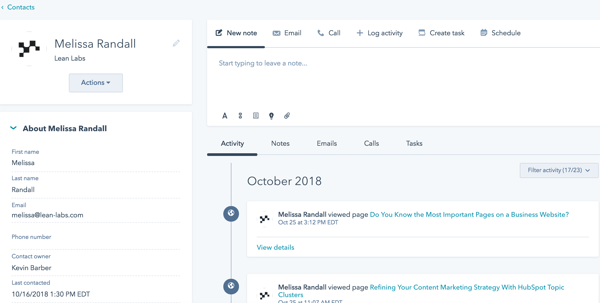
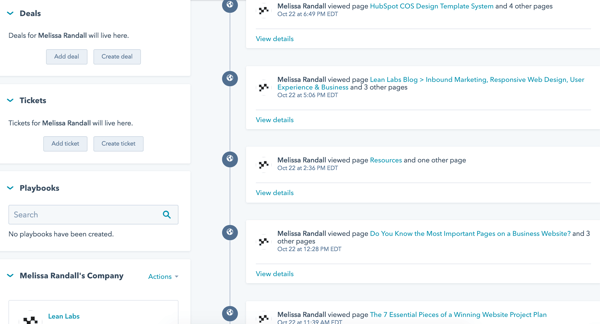
There's also website performance monitoring tools, so we can get an overview of how our site, website pages, and landing pages are performing.
.png?width=600&name=views%20(1).png)
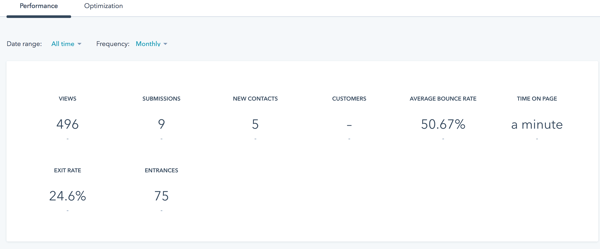
We can integrate their entire experience and also use the platform to conduct email marketing campaigns, host a blog, experiment with video and more. HubSpot also collects data regarding those initiatives, giving us the most accurate picture about how leads are engaging with us.
We feel so passionately about an investment in HubSpot vs. WordPress; we have an entire web page dedicated to explaining the differences.
#6: See Your Website As A Tool
Your website should be a resource for your customer, but it should also act as a part of your team. Right now, think about all of the time your team spends on manual administrative tasks. They answer common questions, follow-up with every customer individually, spend a ton of time on the phone, etc. And it may not even be worth it. With all of the back and forth between tools, you can lose a lot of data.
How many times has your sales rep spoken to a singular customer? Did the sales rep keep track? It's a lot of information for a small team to track and monitor. It's nearly impossible when it's spread between spreadsheets, notes, call recordings, etc. You miss out on so many leads this way, I promise. You're only human and can't be everywhere all the time.
With the right website, however, you can use humans wisely. A lot of CMS and COS platforms offer a variety of tools that help you automate and track correspondence and customer behavior. The newest and most exciting features that HubSpot has, for instance, include:
Chatbots
You can use HubSpot's Chatbot Builder to respond to customers in real time, deliver content assets, ask qualifying questions and offer responses to frequently asked questions. I recently engaged with HubSpot on Facebook Messenger and got a real-time example of how they're using the bot to obtain additional information about their customers.
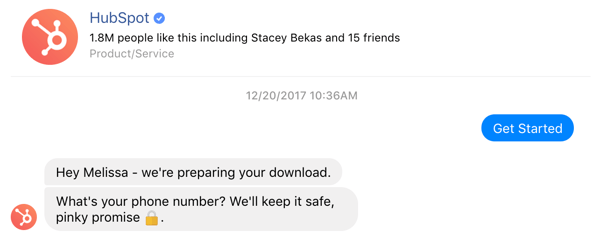
Smart CRM
There are a lot of CRMs out there, but they're not all created equal. I've used a few, but the free HubSpot CRM blows them out of the water. With this CRM, you can track every single action your contacts take (as you saw up in the contact record.) You can also use the CRM in addition to HubSpot's other smart features, such as smart lists, to segment and keep track of incoming contacts, leads, opportunities, and customers.
Smart Content
If you've ever gone to a landing page or website page that knew your name, location or buyer journey stage, you may have been on a page that was using the smart content. Smart content targets customers with a specific message depending on where they are in the buyer journey. This way, you can speak to TOFU leads differently than a BOFU lead, and so forth.
Smart CTAs
If you use smart calls-to-action, you can present contacts with an Ebook or offer that matches their stage. With smart CTAs, you can manage your website and ensure that visitors engage with the right content, at the right time.
Video
With HubSpot video, you can track the engagement of any video you upload and embed on your website. All of your video files can live on the HubSpot platform, and you can add them to any page. You can add CTAs and forms to your videos and track the performance of your content over a period.
All of these features ensure an exceptional experience for your customer, but also help you obtain a better ROI on your website.
The Key To Small Business Websites
Overall, no matter what tools you use to build your website, you need a plan. Because without the right approach, it's easy to blow your budget and make the wrong site. Any time that you saved skipping over the strategy or adding extra revision cycles will go to waste. In six or so months, you won't be getting the results you need, and you will be right back to where you started.
If you're a small business, you need results immediately. That's why getting your site right the first time is so critical. While I know that HubSpot is the perfect resource for building that website, admittedly, the upfront costs can be expensive. It's a significant investment to make.
However, with our exclusive savings guide, you can save up to 60% off in your first year with HubSpot. And if you're a small business that's hungry for results, a year is all you need.
As an Inbound Writer for Lean Labs, Melissa writes about high-converting websites and customer-centric marketing. She's an avid traveler, with trips to Iceland, Ukraine, and Portugal under her belt. She currently resides in Wilmington, North Carolina with her dog, Morrie.
About Lean Labs
The only outsourced growth team with a track record of 10X growth for SaaS & Tech co's. 🚀
Explore Topics
Recent
Related
Popular
- 3-Step Proven Startup Growth Strategy (+ Examples)
- What is a Good Bounce Rate? (+ The #1 Reason Yours is Too High)
- HubSpot CRM Onboarding Cheat Sheet: 8 Key Steps to Success
- Setting a Marketing Budget for a Tech Startup (+ How To Make It Profitable)
- How To Make Website ADA Compliant in 9 Simple Steps
- How to Repurpose Your Content: The Best Way to Increase ROI
- Is HubSpot the Best Marketing Platform Choice for Startups?
- The In-House Business Video Production Process to Make Video Content Fast and Easy
- The Exact Email Marketing KPIs You Should Focus On (and Why)
- Ask The Experts: How to Increase Organic Search Traffic

Discover the Hidden Strategies We Use to 10X Our Clients Growth in 36 Months!
The Growth Playbook is a FREE guide to planning, budgeting and accelerating your company’s growth.


